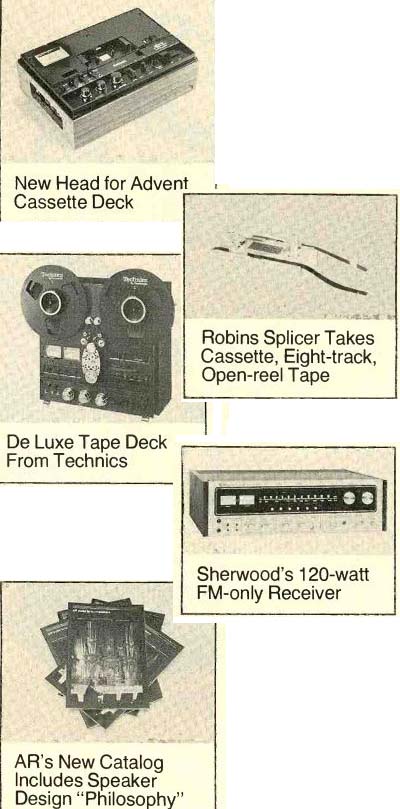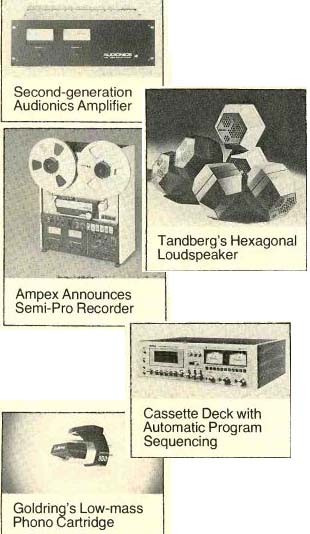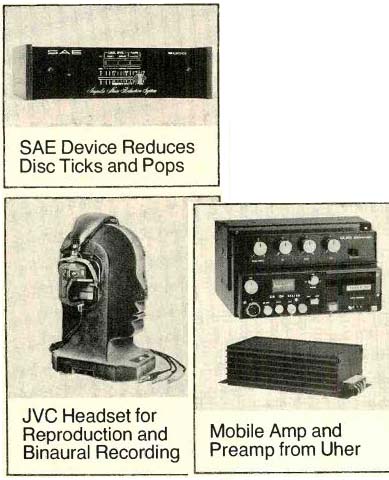
Advent 201A stereo cassette deck
The new Advent 201A stereo cassette deck, an evolutionary successor to the Model 201, has a "Sendust" alloy record-playback head that is reported to combine the desirable performance characteristics of permalloy with the wear resistance of ferrite materials.
Another added feature of the 201A is a stereo-headphone amplifier, the output of which is connected to a standard phone jack on the side of the unit. The transport of the original 201 is retained, as are all the control and performance features, including the single recording-level meter that can be switched to read either channel or the higher of the two.
Frequency response of the 201A is 28 to 15,000 Hz ±2 dB, with an A-weighted signal to-noise ratio exceeding 60 dB with chromium-dioxide tape and 57 dB with "standard" tape. Wow and flutter are less than 0.08 percent (JIS weighting). Distortion, which is tape dependent, will not be affected by more than 0.1 percent by the electronics up to and beyond tape saturation. The Advent 201A measures approximately 14 x 4 1/2 x 9 1/4 inches; it is supplied with a plastic dust cover. Price: $399.95.
AR's New Catalog Includes Speaker Design "Philosophy"
Acoustic Research's new full-color catalog (thirty-six pages) describes in detail the company's current loudspeaker line and its approach to sound reproduction in general. The first part of the catalog deals with the standard of accurate reproduction as defined by AR, as well as the testing and manufacturing of AR speaker systems. The concluding sections deal with speaker evaluation, installation, and use, plus the physics of sound production and reproduction. The catalog is approximately paperback size (8 1/4 x 5 1/2 inches); it is avail able free from selected AR dealers or for $1 from Acoustic Research, 10 American Drive, Norwood, Mass. 02062.
An "Isolated Loop" tape-drive system is a feature of the RS-1500US stereo open-reel deck from Technics by Panasonic. The Isolated Loop employs a single large capstan with two pinch rollers that engage the tape at the beginning and end of the loop. Forming the loop itself is a cluster of four heads (half-track erase, record, and playback, plus quarter-track playback) and a guide roller at the bottom. The roller carries stroboscopic markings that are illuminated by a strobe lamp. The capstan motor is speed-governed by a quartz-crystal oscillator and a phase-locked loop, providing speeds of 15, 7 1/2, and 3 3/4 ips. Separate direct-drive motors power the reels, which can be up to 10 1/2 inches in diameter.
The RS-1500US transport has all-electronic rather than electromechanical (solenoid) switching. Among other features are front-panel bias and equalization switching for different tape types, a pitch control with a range of 12 percent, a real-time index counter, and various facilities for tape editing and splicing.
The recording-level meters are true average-reading devices switchable in sensitivity. A timer can be connected for unattended recording. Heads are readily replaceable and are said to be align-able by the user.
Frequency response is 30 to 30,000 Hz at 15 ips and 30 to 25,000 Hz at 7 1/2 ips, both ±3 dB.
The weighted signal-to-noise ratio is 60 dB, and wow and flutter are 0.018 percent (wrms) at 15 ips. The dimensions of the machine are 18 x 17 1/2 x 10 1/2 inches; it weighs 51 pounds. Price: approximately $1,500.
Robins Splicer Takes Cassette, Eight-track, Open-reel Tape
A new Robins splicing jig has side-by-side grooves for the 1/4-inch tape of eight-track cartridges and open-reel as well as the narrower tape used in cassettes. Spring-loaded fingers that can be flipped to one groove or the other hold the tape that is to be cut by a single edged razor blade and then joined by standard splicing tape. A length of double-face tape is supplied to secure the jig to a tape machine or other convenient surface. The splicing jig is Robins catalog No. R26060. Price: $2.89.
Sherwood's 120-watt FM-only Receiver
The 58910 closely resembles the other top Sherwood receivers in performance and appearance, except that it lacks an AM tuner section. Its continuous-power output of 60 watts per channel is available at any frequency from 20 to 20,000 Hz with no more than 0.1 percent harmonic or intermodulation distortion. The FM section employs Sherwood's "digital-detector circuit" together with a phase-locked-loop multiplex stage. Usable sensitivity is 1.7 microvolts, with 2.7 microvolts needed for 50-dB quieting with a mono signal. Capture ratio is 1 dB, AM suppression is 65 dB, and spurious-response rejection is 95 dB. Alternate-channel selectivity is 75 dB.
Special features of the S8910 include provisions for monitoring from and dubbing be tween two tape decks, switching between two pairs of speakers, connections for a four-channel matrix adapter, and FM de-emphasis that is switchable between 75 and 25 microseconds (to facilitate the use of a Dolby decoder on Dolbyized FM broadcasts). In one position of the speaker-selector switch, rear speakers are connected to the receiver's out puts differentially, providing a simple speaker matrix for simulated four-channel effects.
The S8910's dimensions are approximately 21 1/4 x 6 x 15 3/4 inches. A wood cabinet finished in walnut veneers is supplied. Price: under $500.
Second-generation Audionics Amplifier
The HP series of stereo power amplifiers offers evolutionary refinements over the original Audionics products. The new PZ3-ii in particular, rated at 100 watts per channel continuous within the full audio band with no more than 0.03 percent harmonic distortion, is now optionally available with peak-reading output-level meters and a black-anodized front panel suitable for rack mounting.
The full complementary-symmetry design of the PZ3-ii includes what Audionics calls a "dynamically biased" output stage, said to be responsible for reduced notch and high-frequency distortion. Wide-bandwidth driver and output transistors are used, while the audio passband has been deliberately limited to 70,000 Hz. Input for rated output is 1 volt into the amplifier's 22,000-ohm input impedance. The signal-to-noise ratio exceeds 95 dB. Dimensions: 19 x 6 x 15 inches. The PZ3-ii is $529 equipped with meters and gain controls.

Goldring's Low-mass Phono Cartridge
Hervic Electronics is the importer of the Goldring G900 SE stereo phono cartridge, a design whose weight of only 5 grams is made possible by the use of new materials and construction techniques. The G900 SE is a moving-magnet cartridge designed to track over a stylus-force range of 0.75 to 1.5 grams. Frequency response is 20 to 20,000 Hz ±2 dB, and stereo separation is nominally 25 dB. The output of the cartridge is 1 millivolt percent, meter per second of recorded velocity, with a recommended load of 47,000 ohms shunted by a capacitance of 150 to 200 picofarads.
The G900 SE's stylus is elliptical in shape, with dimensions of 0.7 x 0.2 mil. The pickup provides a vertical tracking angle of 24 degrees. Price: $120.
Ampex Announces Semi-Pro Recorder
After a long absence, Ampex has returned to the audio-hobbyist market with a new open-reel tape deck suitable for professional or audiophile use. The ATR-700 is available in half- or quarter-track stereo versions and even in mono (full-track). The three-motor, solenoid-switched transport is equipped with various editing features such as a pause control, a switch that disables the tape lifters, and a "tape-spill" function that permits operation without the take-up reel being used. Either gap on the record head can be switched to playback duty for track synchronization.
Controls include four-in, two-out mixing capability, a master recording-level control, and a variable-speed adjustment operable on all three speeds (15, 7 1/2, and 3 3/4 ips). The two built-in microphone preamplifiers have balanced inputs.
The ATR-700 is set up for various types of Ampex tape as well as for Scotch (3M) 250.
Front-panel switches provide three different positions for both recording bias and equalization. With the recommended tapes, frequency response is 40 to 18,000 Hz at 15 ips, 40 to 15,000 Hz at 7 1/2 ips, and 40 to 7,500 Hz at 3 3/4 ips, all ±2 dB. Signal-to-noise ratio (A-weighted) is 55 dB for quarter-track and 60 dB for half-track. Wow and flutter (NAB) are 0.08 percent for the two higher speeds. The machine takes reels up to 10 1/2 inches.
Approximate dimensions are 21 3/4 x 17 1/2 x 9 3/4 inches. Price: $1,695. An optional remote control with 16-foot cable costs $115. A portable carrying case will also be available.
The Fasett speaker system, new from Tandberg, is a compact design (11 x 9 1/2 x 8 3/4 inches) that presents a hexagonal profile when viewed from the front. Within the bass-reflex enclosure are a 5-inch woofer and a 2 1/4-inch cone tweeter. The multiple sides of the enclosure provide for a number of mounting schemes, including installation with drivers facing directly at or somewhat away from the listener, or drivers angled somewhat upward.
The Fasett can also be hung, or attached to the wall by means of keyhole slots in its rear.
The Fasett system's impedance ranges be tween 4 and 8 ohms, and its power-handling capability is 25 watts continuous or 40 watts program material. An input of 6 watts produces a 96-dB output level at a distance of 1 meter. Frequency range is 50 to 20,000 Hz. The Fasett is available in black, antique-white, and orange. Price: $160 per pair.
Cassette Deck with Automatic Program Sequencing
"Automatic Program Locate Device" is Sharp Electronics' nomenclature for the sequential programming system in the Optonica RT-3535 stereo cassette deck. The system is controlled by nine push keys labeled 1 through 9. The numbers are meant to correspond to recorded selections on the cassette;
these selections are played in the order in which they are entered on the keyboard. A circuit within the deck locates and "counts" the intervening unrecorded sections to identify each selection. A tenth CLEAR key wipes out the sequence and prepares the system for new commands. An LED indicator identifies the selection being played by number.
The RT-3535 is a front-loading two-motor machine with Dolby noise reduction and switchable bias and equalization for all cur rent tape types. There is also a switchable limiter circuit to automatically prevent over-recording and a novel SPACE function that inserts an appropriate unrecorded interval be tween selections when a recording is being made. Frequency response is 30 to 15,000 Hz with "normal" tape, 30 to 16,000 Hz with chromium-dioxide tape, and 30 to 17,000 Hz with ferrichrome, all ±3 dB. Signal-to-noise ratio is 58 dB without Dolby circuits; wow and flutter are 0.04 percent (wrms). Approximate dimensions of the RT-3535 are 18 1/2 x 5 3/4 x 14 inches. The machine has simulated walnut side panels. Price: about $430.
SAE Device Reduces Disc Ticks and Pops
The Model 5000 from Scientific Audio Electronics is described as an "Impulse Noise Reduction System" intended specifically to suppress or eliminate the clicks, pops, and scratches that intrude on disc-record reproduction. The operation of the device is based on the differences that distinguish such noises from program material, including attack and decay times and phase characteristics. An electronic "program" circuit, together with a logic circuit, detects the presence of impulse noise and interrupts the audio signal for its (usually very brief) duration. In addition, the recorded material just before the noise is used by the Model 5000 to "fill in" the interruption with a suitable extrapolated signal that thoroughly masks the operation of the device.
The SAE 5000, which is intended to be in stalled in the tape-monitor loop of an audio system, is a stereo processor with a continuously variable sensitivity control. Pushbuttons defeat the action of the 5000 and also invert it, so that the only sounds you hear are the clicks and pops that are being removed, rather than the recorded material; this is in tended as an aid in setting the sensitivity control as well as a demonstration of the device's efficacy. There are tape-monitor facilities to replace those taken up by installation. Harmonic and intermodulation distortion are less than 0.1 percent, and frequency response is 20 to 20,000 Hz ±1 dB. The 5000 has an input impedance of 75,000 ohms and a maximum output of more than 9 volts into 10,000 ohms.
Insertion loss is less than 1 dB and the signal to-noise ratio exceeds 90 dB. Dimensions: 3 x 9 1/2 x 10 3/4 inches. Price: $200.

JVC Headset for Reproduction and Binaural Recording
The JVC HM-200E is a headset containing both dynamic transducers for listening and a pair of electret-condenser microphone capsules for making binaural recordings. The microphone elements are mounted on the out side of each earpiece within cavities that simulate the shape of the external ear and as close as possible to the actual ear of the wearer. The electret capsules are powered by AA cells contained within the earpieces. A three-position microphone switch provides fiat frequency response, low-frequency attenuation, or "off." Overall microphone response is 50 to 10,000 Hz ±10 dB. Output impedance is 600 ohms, and the microphones' electronics provide a signal-to-noise ratio exceeding 45 dB.
The headphones in the HM-200E are of the acoustically isolating type with thickly padded ear cushions and headband. The phones have a frequency response of 50 to 10,000 Hz, an impedance of 8 ohms, and a level switch.
Air seals and partitioning prevent any acoustical interference with the microphones. The entire headset weighs just over 1 1/2 pounds.
The cables are about 6 feet long, terminating in a three-conductor stereo phone plug for the headphones and a pair of two-conductor phone plugs for the mikes. Also supplied is a polystyrol-foam dummy head (with screw sockets for microphone stands and adapters) to be used for recording without the opera tor's having to wear the headset. Price: approximately $80.
As a companion to the Uher portable stereo cassette machines, the manufacturer now offers a two-piece amplifier/preamplifier combination for automobiles, boats, or any other vehicle with a 12-volt storage battery.
The separate power amplifier installs in any convenient space; since it switches on automatically when it senses an audio signal at its input, it is unnecessary to route its battery connections through the preamplifier for on/ off switching. The preamplifier, which pro vides bass, treble, mid-range, and balance controls, occupies the upper part of a special under-dash mounting-bracket assembly. Beneath it, a compartment receives the tape ma chine, which mates with a signal/power-cable connector when slid into place.
Mobile Amp and Preamp from Uher
The power amplifier is rated at 25 watts per channel continuous into 8 ohms from 50 to 20,000 Hz with no more than 3 percent harmonic distortion. The preamplifier's tone controls have a range of ±17 dB at 35 Hz, ±8 dB at 1,000 Hz, and ±15 dB at 30,000 Hz. The preamp/mounting-bracket assembly is just slightly wider than the 7-inch width of the Uher portables and about 4 inches high. The combination of preamp/bracket and power amp is designated the CR200 "Stereomatic." Price: $195.
NOTICE: All product descriptions and specifications quoted in these columns are based on materials sup plied by the manufacturer.
Recent fluctuations in the value of the dollar will have an effect on the price of merchandise imported into this country. Please be aware that the prices quoted in this issue may be subject to change.
Also see:
TAPE RECORDING--A professional shares his tips on how to do it right, JOHN WORAM